View in other NatureServe Network Field Guides
NatureServe
Montana
Utah
Wyoming
Idaho
Wisconsin
British Columbia
South Carolina
Yukon
California
New York
A Pseudoleskea Moss - Pseudoleskea stenophylla
Other Names:
Lescuraea stenophylla
General Description
Plants: Pleurocarpous, growing in loose, thick or slender mats, green or green with yellow tones, becoming brown over time. Stems ends mostly straight, the tips seldom hooked upward, seldom catkin-like, freely branched (FNA 2014), sometimes reaching 5 cm (Lawton 1971), possessing a central strand; paraphyllia numerous; rhizoids borne in groups on leaves near the leaf attachment (FNA 2014).
Leaves: Shiny, lying close together near the stem to nearly upright when dry, spreading to about 45 degrees when damp, 0.9-2 mm in length (FNA 2014), 0.3-0.5 mm in width (Lawton 1971), lance-shaped, sometimes also tending toward ovate, tapering slowly to a long, narrow acumen half the length of the leaf, without a hair-point, usually only the apex curved in sickle-like fashion, if at all; leaf edges curved back and downward below to near the acumen, smooth to finely saw-toothed above; costa extending to the leaf tip, sometimes tinged with yellow, not wavy (FNA 2014). Branch leaves a bit smaller, usually with the tip finely saw-toothed (Lawton 1971).
Leaf Cells: Lower laminal cells generally shorter but otherwise resembling medial cells; medial cells somewhat long and diamond-shaped to long, slender and wavy, sometimes with both ends tapering, quite papillose, the papillae typically close to the far end of the cell rather than centered, the walls nonporose and thick to moderately thick, seldom with cell ends overlapping and protruding; alar cells square to somewhat long, the longer dimension crosswise to the leaf length (FNA 2014).
Phenology
Fruit ripens in mid-spring through mid-summer (FNA 2014).
Range Comments
North American Range
AK, BC and AB s to CA, ID, UT and MT, also QC to NL and NS (FNA 2014). Also known in Montana from Beaverhead, Flathead, Glacier, Lake, and Lincoln Counties (Elliott and Pipp 2016).
Observations in Montana Natural Heritage Program Database
Number of Observations: 8
(Click on the following maps and charts to see full sized version)
Map Help and Descriptions
Relative Density
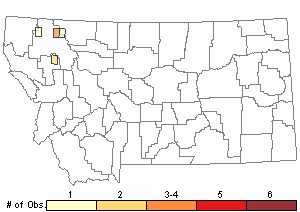
Recency
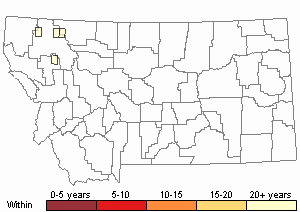
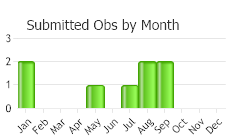
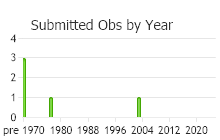
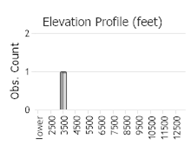 (Observations spanning multiple months or years are excluded from time charts)
(Observations spanning multiple months or years are excluded from time charts)
Habitat
Small to larger branches of small trees and bushes, beside watercourses. Occurring from mid-elevations to 6890 feet (FNA 2014).
Reproductive Characteristics
Dioicous. Seta 5-10 mm tall (Lawton 1971). Capsule upright, 1-3 mm in length (FNA 2014); exostome teeth ochre with fine, level lines and ridges, taller than the endostome processes; cilia absent (Lawton 1971).
Stewardship Responsibility
References
- Literature Cited AboveLegend:
 View Online Publication
View Online Publication Elliott, J.C. and A.K. Pipp. 2018. A Checklist of Montana Mosses (1880-2018). Updated 3 January, 2020. Montana Natural Heritage Program, Helena, Montana. 73 pp.
Elliott, J.C. and A.K. Pipp. 2018. A Checklist of Montana Mosses (1880-2018). Updated 3 January, 2020. Montana Natural Heritage Program, Helena, Montana. 73 pp. Flora of North America Editorial Committee, eds. 2014. Flora of North America North of Mexico. Volume 28. Bryophytes: Mosses, Part 2. Oxford University Press, Inc., NY. xxi + 702 pp.
Flora of North America Editorial Committee, eds. 2014. Flora of North America North of Mexico. Volume 28. Bryophytes: Mosses, Part 2. Oxford University Press, Inc., NY. xxi + 702 pp. Lawton, E. 1971. Moss Flora of the Pacific Northwest. Hattori Botanical Laboratory. Japan: Yamabuki-cho, Shinjuku-ku, Tokyo. 362 pages plus appendices.
Lawton, E. 1971. Moss Flora of the Pacific Northwest. Hattori Botanical Laboratory. Japan: Yamabuki-cho, Shinjuku-ku, Tokyo. 362 pages plus appendices.
- Additional ReferencesLegend:
 View Online Publication
View Online Publication
Do you know of a citation we're missing? Elliot, J. C. 1993. Second checklist of Montana mosses. Unpublished report. U.S. Forest Service, Region 1. Missoula, MT. 45 pp.
Elliot, J. C. 1993. Second checklist of Montana mosses. Unpublished report. U.S. Forest Service, Region 1. Missoula, MT. 45 pp. Lawton, E. 1971. Keys for the Identification of the Mosses on the Pacific Northwest. Reprinted from 'Moss Flora of the Pacific Northwest'. Published as Supplement No. 2 of the Journal of the Hattori Botanical Laboratory. Nichinan, Miyazaki, Japan. 66 pp.
Lawton, E. 1971. Keys for the Identification of the Mosses on the Pacific Northwest. Reprinted from 'Moss Flora of the Pacific Northwest'. Published as Supplement No. 2 of the Journal of the Hattori Botanical Laboratory. Nichinan, Miyazaki, Japan. 66 pp. Malcolm, B., N. Malcolm, J. Shevock, and D. Norris. 2009. California Mosses. Nelson, New Zealand: Micro-Optics Press. 430 pp.
Malcolm, B., N. Malcolm, J. Shevock, and D. Norris. 2009. California Mosses. Nelson, New Zealand: Micro-Optics Press. 430 pp.
- Web Search Engines for Articles on "A Pseudoleskea Moss"





